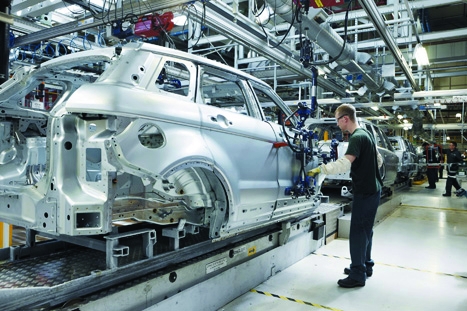 The automobile industry is currently one of the fastest-growing sectors in India. The country is the seventh-largest producer in the world, with an average annual generation of 17.5 million vehicles every year. According to a record of the Society of Indian Automobile Manufacturer (SIAM), India is also the fourth largest automotive market by mass. The sector provides seven percent of the country’s GDP by volume.
The automobile industry is currently one of the fastest-growing sectors in India. The country is the seventh-largest producer in the world, with an average annual generation of 17.5 million vehicles every year. According to a record of the Society of Indian Automobile Manufacturer (SIAM), India is also the fourth largest automotive market by mass. The sector provides seven percent of the country’s GDP by volume.
There is a strong rise in automobile manufacturing assemblies all over India. Multi-national corporations — such as Hyundai, Ford, Volkswagen, and several other companies — have opened manufacturing assemblies in the outskirts of Chennai (known as the Detroit of India).
Although there is still a long way to go before India becomes a leader in automotive manufacturing, it’s expected that the country will become a recognized hub for low-cost, high-quality engineering in the field. This means there are numerous opportunities for students studying in Southern India. However, Chennai is not alone. Gujarat, Maharashtra, and Delhi have also seen a growth in automotive manufacturing and related investments.
Automobile engineering is a branch of engineering that includes the design, assembly, testing, production, and the safety and operation of automobiles, including electric vehicles. It’s a challenging, yet much-needed industry job. An automobile engineer must learn multiple subjects, including electrical engineering, mechanical engineering, software engineering, safety, and even environmental sustainability and regulations.
Automobile engineers are, currently, in large demand in India and abroad. As it’s a vast industry, there are great employment opportunities in multiple sectors and particularly in design engineering. This is particularly true as efficiency and environmental considerations weigh on consumers. It’s also significant as autonomous driving becomes a potential.
Thanks to the Ministry of the Republic of India’s “The Automotive Mission Plan (AMP) II 2016-26,” which aims to support and more fully develop the automobile industry in the country, job opportunities in the sector are expected to grow considerably.
Basic qualification
In India, students interested in studying automobile engineering must have a qualified Class 12 with minimum 50% marks in chemistry, physics, and mathematics from a recognized board in the country. Candidates, who wish to join the Indian Institutes of Technology (IITs), the autonomous public institutes of higher education, should have cleared the joint entrance examinations — both main and advanced.
Those seeking admission to a National Institute of Technology (NIT) in India also must have scored well on the JEE’s main score.
For diploma courses in automotive engineering, candidates should have passed 10+2 in science stream with 50% marks in PCM subjects from recognized university. The duration of the course is four years for full-time students.
To pursue post-graduate course in automotive engineering, candidates should have bachelor’s degree in automotive engineering from a recognized university.
A few of the courses in this field are:
- Diploma in Automotive Engineering
- Bachelor of Engineering in Automotive Engineering
- Bachelor of Technology in Automotive Engineering
- Master of Technology in Automotive Engineering
- Master of Technology in Automotive Engineering
Area of specialization include:
- Engine systems
- Fluid mechanics
- Rapid prototyping
- Alternative fuels
- Electronics and control systems
- Fuel technology and emissions
- Computer-based systems and electronics
- Emissions control
- Aerodynamics
- Thermodynamics
- Vehicle and pedestrian safety or supply chain management
Opportunities
The industry proposes many challenging and exciting roles for skilled professionals. Some of the traditional roles include:
- Creating a blueprint of carriers and its components
- Designing, improvement, and manufacturing vehicles
- Preservation and Services Engineers in automobile workshops, aviation, aircraft industries, marine boats, and diesel-power stations
The salary package of an engineer depends on many factors such as the size of the organization, profile, qualification, experience, and company location. It also depends on education. Typically, students from IITs or NITs earn more than those graduated from a private college.
Some of the top recruiters in the industry include:
- TELCO
- L & T
- Ashok Leyland
- Mahindra & Mahindra
- Heldex India
- Bajaj Auto
- Hyundai
- Hero Moto Corp
- Volkswagen
- Audi
- Renault
- Maruti Suzuki
- Toyota
- Yamaha
The future of automobiles
According to industry surveys, the automobile sector is expected to sell more than six million vehicles by 2020. That means there are plenty of engineering jobs for the taking.
Additionally, electrification has just begun to advance in India. Factors, such as decreasing battery costs and supportive government policies are spurring the segment’s growth. In 2017, only 2,352 units of electric vehicles were sold. However, 10,000 electric cars were requested by the government’s energy-service company (Energy Efficiency Services Ltd.).
Similarly, local authorities in 10 Indian cities have placed orders for 390 electric buses, with another 1,000 e-buses expected on the order books.
The automotive industry should prepare for a changing landscape and that will require engineers who are up to the task.
Filed Under: Applications, Automotive, Blog entry, Tech Articles


Questions related to this article?
👉Ask and discuss on Electro-Tech-Online.com and EDAboard.com forums.
Tell Us What You Think!!
You must be logged in to post a comment.